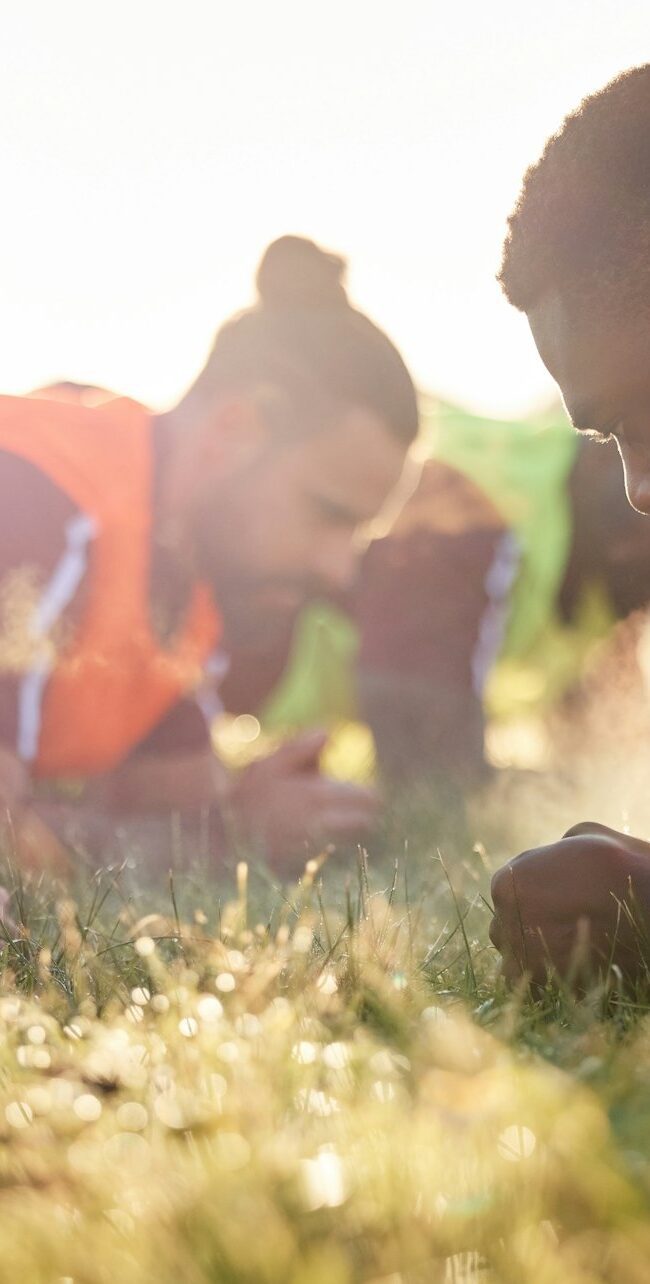
Introduction
The Paleolithic era, commonly known as the Stone Age, spans a period from roughly 2.5 million to 10,000 years ago. It was a time when early humans relied on nature’s raw offerings, utilizing simple tools and the environment around them to survive. Life was primal, and the daily challenges these ancestors faced molded their nutrition, physical activity, and overall lifestyle.
Fast forward to today’s digital age, and many of us find ourselves in a maze of processed foods, sedentary habits, and digital distractions. The caveman’s life, despite its apparent hardships, offers a blueprint for a natural, holistic approach to health and well-being. Living as our ancestors did holds allure, not as a regression, but as a way to reconnect with our biological roots. This reconnection can serve as a counterbalance to the strains of modern living, potentially leading to improved health, greater vitality, and a deeper appreciation for the world around us.
This 30-day Caveman Challenge invites you to embark on a transformative journey. We’ll explore the fundamentals of a ‘caveman’ diet, delve into physical activities that mirror our ancestral movements, and tap into lifestyle habits that bring us closer to nature and our innate selves. Are you ready to discover the ancient wisdom embedded in your genes? Let’s dive in!
Chapter 1: The Caveman Diet
Basics of Paleo Nutrition
The term “Paleo” is derived from the Paleolithic era and is used to describe a way of eating that harks back to a time when our diet was dictated by nature and availability. Our ancestors were hunters and gatherers, thriving on a diverse range of foods that they could hunt or forage. There was no farming, and hence, no grains or dairy.
At the core of Paleo nutrition is an emphasis on whole foods. Picture lean meats from animals that roamed freely, fish fresh from pristine waters, a medley of wild nuts, an abundance of leafy greens, regional vegetables plucked straight from the earth, and seeds that were the forerunners of life. These foods were nutrient-dense, free from modern-day pesticides and fertilizers, and were consumed in their most natural state.
Processed foods were non-existent. There were no sugars, save for the occasional wild honey or berries. Dairy, having been introduced with the advent of farming, was also absent from their diet. Grains, legumes, and artificial additives? They didn’t have a place on the caveman’s plate either.
Benefits of the Caveman Diet
- Natural Weight Management: Without processed foods and sugars, the caveman diet is naturally low in empty calories and high in nutrients. This balance allows for better appetite regulation and encourages the body to tap into fat reserves for energy, aiding in weight management.
- Improved Gut Health: The exclusion of dairy, grains, and legumes – common irritants for many people’s digestive systems – combined with the emphasis on whole, fibrous foods, nurtures gut health. This can lead to improved digestion, reduced bloating, and a lower risk of gut-related issues.
- Potential Reduction in Allergies and Sensitivities: Many modern-day allergies and sensitivities can be traced back to foods or additives that weren’t a part of our ancestral diet. By returning to a caveman way of eating, some individuals find relief from chronic allergies and intolerances.
Sample Meal Plan for a Week:
Day 1:
- Breakfast: Scrambled eggs with spinach and avocado. Fresh blueberries on the side.
- Lunch: Grilled chicken salad with mixed greens, cherry tomatoes, cucumbers, and olive oil dressing.
- Dinner: Wild-caught salmon with roasted asparagus and garlic.
Day 2:
- Breakfast: Almond butter smoothie with coconut milk and strawberries.
- Lunch: Beef stir-fry with bell peppers, broccoli, and ginger.
- Dinner: Pork loin roast served with sautéed zucchini and squash.
Day 3:
- Breakfast: Omelette with mushrooms, onions, and fresh herbs. A handful of walnuts.
- Lunch: Tuna salad with hard-boiled eggs, olives, and mixed greens.
- Dinner: Grass-fed steak with sweet potato wedges and steamed green beans.
Day 4:
- Breakfast: Banana and mixed nut (almond, cashew, walnut) bowl drizzled with a little raw honey.
- Lunch: Shrimp avocado salad with lime and cilantro dressing.
- Dinner: Bison or grass-fed beef burger (no bun) with a side of mixed vegetables sautéed in coconut oil.
Day 5:
- Breakfast: Coconut and chia seed pudding topped with fresh berries.
- Lunch: Roast turkey or chicken slices wrapped in large lettuce leaves with sliced tomato, cucumber, and a dash of guacamole.
- Dinner: Lamb chops marinated in rosemary and garlic, grilled to perfection, served with roasted Brussels sprouts.
Day 6:
- Breakfast: Fruit salad made with kiwi, pineapple, and mango, sprinkled with some shredded coconut.
- Lunch: Vegetable soup made with bone broth, carrots, celery, and onions. Side of smoked mackerel or sardines.
- Dinner: Venison or other wild game meat (if available) with a side of baked beetroot and carrot sticks.
Day 7:
- Breakfast: Sautéed kale and sun-dried tomatoes with poached eggs.
- Lunch: Mixed nut and berry salad with a simple dressing of olive oil and apple cider vinegar.
- Dinner: Grilled trout or other freshwater fish with a side of parsnip and turnip mash.
Stepping into the shoes (or perhaps, bare feet) of our ancestors, this dietary shift encourages us to think deeply about our food sources, quality, and preparation. It’s more than just a diet; it’s a celebration of nature’s bounty and a nod to our evolutionary roots. It brings forth the primal essence of who we are and allows us to rekindle that bond with the earth and its produce.
This week’s meal plan is just a starting point. The beauty of the caveman diet lies in its simplicity and adaptability. As you embrace this journey, you’ll be inspired to experiment, mix, and match, finding combinations that not only satiate your taste buds but also fuel your body in the most nourishing way possible. Let this be a week of exploration, gratitude, and culinary adventure. As we always say, eat not just to fill your stomach, but to nourish your soul.
Embracing the caveman diet is not just about following a trend; it’s about understanding the fundamental relationship between our body’s evolutionary design and the fuel it thrives on. As we progress in this challenge, you’ll come to appreciate the vitality and vigor that such a diet brings. Onward to a healthier you!
Chapter 2: Physical Activity the Caveman Way
For our ancient ancestors, the modern-day notion of “going to the gym” would’ve been utterly foreign. Instead, every day was a natural workout, shaped by survival needs and environmental demands. Physical activity wasn’t a scheduled part of the day; it was the day. This chapter guides you to reintegrate those primal movements and challenges into your contemporary life.
Move Naturally and Often
In the Paleolithic era, movement was constant and diverse. They didn’t ‘exercise’ for the sake of it; they moved because it was essential. Whether it was hunting, gathering, building shelter, or playing, everything was physically involved.
Importance of regular, varied movement: Unlike today’s sedentary lifestyle, cavemen rarely sat for extended periods. Their bodies were in regular motion, leading to better cardiovascular health, leaner physiques, and lesser lifestyle diseases. Incorporating a variety of movements throughout the day, such as walking to work or taking stairs, can have profound health benefits.
Functional fitness: These are exercises that help you perform daily activities more easily and without injuries. Instead of isolating muscle groups, functional fitness mimics natural movements. This includes tasks like lifting (picking up something off the ground), squatting (sitting down and standing up), walking long distances, and running either at a steady pace or in quick bursts.
Strength and Endurance
The need to hunt and defend made strength and endurance paramount in the caveman era. While we no longer need these skills for survival, they’re crucial for overall health and fitness.
Bodyweight exercises: Before the invention of modern gym equipment, the human body was the primary resistance tool. Embrace exercises like push-ups, squats, lunges, and jumps. These compound movements engage multiple muscle groups, offering a comprehensive workout that builds strength and enhances stability.
Interval running: Think of how a hunt might go—periods of stalking quietly and patiently followed by sudden, intense chases. To replicate this, try interval running. After a warm-up, sprint as fast as you can for 30 seconds and then walk or jog for 90 seconds. Repeat this cycle for about 20 minutes. This form of high-intensity interval training (HIIT) can boost metabolism, improve cardiovascular health, and enhance muscle endurance.
Flexibility and Mobility
While strength and endurance were vital for survival, flexibility and mobility were equally important to navigate through diverse terrains and avoid injuries.
Stretching routines inspired by natural movements: Think of the way animals stretch—intuitively and in response to their body’s signals. Stretching should flow naturally. Begin with deep breaths, followed by gentle stretches, reaching up like a tree towards the sun or bending down, touching the earth. Flow from one movement to another, perhaps imitating the stretch of a cat or the stance of a monkey.
Using the environment: Use natural landscapes as your stretching canvas. If you’re near a tree, use its trunk to assist in stretches. Rocks can act as tools to stretch out harder-to-reach muscles or to elevate feet or hands during exercises.
Our ancestors might not have labeled what they did as “yoga” or “HIIT,” but their daily activities incorporated elements of both. Adopting a “caveman” approach to physical activity doesn’t mean forsaking the modern gym but rather incorporating natural, varied, and functional movements into our routines.
Chapter 3: Embracing Nature
Throughout the evolution of our species, nature has always been an intrinsic part of human existence. The concrete jungles we’ve grown accustomed to are but a blip in our extensive history. This chapter delves into the significance of reconnecting with nature and harnessing its myriad benefits for holistic well-being.
The Outdoors as Your Playground
The Paleolithic era didn’t have the four walls that confine many of us today. Our ancestors roamed vast landscapes, basked under the sun, and inhaled the purity of untouched air. This connection to nature wasn’t just a part of their routine—it was their way of life.
Spending more time outside: Modern lives often keep us sheltered indoors, causing us to miss out on vital natural elements. Regular sun exposure is essential for vitamin D synthesis, promoting bone health, mood regulation, and immune system support. Grounding, or walking barefoot on natural surfaces, has been proposed to neutralize free radicals and reduce inflammation. Breathing in fresh air, devoid of artificial conditioning, invigorates the mind and body, improving mental alertness and lung function.
Encouraging activities: To truly connect with nature, immerse yourself in activities that resonate with our ancestral past. Hiking allows us to navigate diverse terrains, echoing the wandering spirit of our forebears. Swimming in natural waters, whether it’s a serene lake or a roaring ocean, revitalizes the senses and offers a workout unlike any pool-based session. Climbing, whether on trees or mountains, tests our agility and strength, reminding us of nature’s vastness and our place within it.
Sleep and Rest
In today’s fast-paced world, sleep often takes a backseat. However, our ancestors knew the value of rest, aligning their sleep-wake cycle with the rise and set of the sun.
Importance of sleep: The cavemen lacked artificial lights, leading them to follow the natural circadian rhythms. This alignment with the day-night cycle optimized their rest, ensuring deep, restorative sleep. Modern research has continually shown the myriad benefits of a proper sleep routine, from enhancing memory and cognitive functions to ensuring optimal hormone secretion.
Benefits of rest: Beyond sleep, moments of quiet rest and reflection were natural to our ancestors. Taking breaks, meditating by a quiet brook, or simply lying on the grass gazing at the clouds—these acts of respite can drastically reduce stress. They promote mental clarity, bolster emotional well-being, and even aid digestion by ensuring the body isn’t always in a ‘fight or flight’ mode.
In conclusion, embracing nature is not about renouncing modern comforts but about intertwining the primal with the present. As we stride ahead in our caveman challenge, let the serenity of nature guide our journey, reminding us of the simple joys and profound wisdom it holds.
Chapter 4: Mental Wellness and Social Bonds
Humans, through the lens of history, have always been social animals. Our Paleolithic ancestors relied on their tribes for survival, emotional support, and shared wisdom. Coupled with a life that was devoid of today’s myriad distractions and incessant pressures, their mental well-being was intrinsically tied to their environment and community. This chapter delves into harnessing lessons from the past to foster mental resilience and forge deep social connections.
Stress Management
The caveman’s day-to-day life, while fraught with survival challenges, was devoid of the constant bombardment of information and choices we face today.
Caveman lifestyle: They dealt with immediate, tangible issues. There was no chronic stress of overflowing inboxes, unending notifications, or societal pressures to live up to. Their problems, while often dire, were straightforward: find food, secure shelter, protect the tribe.
Emulating this: We can’t eliminate modern stressors, but we can manage how they affect us. Digital detoxes, where one unplugs from devices for a set period, can offer a breather from the incessant digital world. Meditation, a practice that transcends time, can center the mind and promote tranquility. Additionally, immersing oneself in nature, as discussed in the previous chapter, acts as a balm to the overwhelmed soul, offering clarity and calm.
Building Strong Social Ties
In the caveman era, one’s tribe was their lifeline. The community wasn’t just about survival but also about shared joys, learnings, and experiences.
Importance of community and belonging: Our ancestors found strength in numbers, not just for hunting or defense, but for emotional and psychological well-being. They celebrated successes together, mourned losses, and faced challenges as a united front.
Engaging in group activities: To forge similar deep connections, consider engaging in group exercises or team sports, evoking the camaraderie of a hunting party. Organize communal meals, where everyone contributes, emphasizing shared responsibility and collective enjoyment. Storytelling sessions, akin to ancient fireside tales, can foster understanding, empathy, and a shared cultural bond.
In essence, while the landscapes of our challenges have shifted over millennia, the core principles of mental wellness remain consistent. Embrace simplicity, seek solace in nature, and cherish community bonds to navigate the intricate maze of modern existence with the wisdom of the ages.
Chapter 5: Practical Tips to Start Your Caveman Journey
Embarking on a journey back to our ancestral roots requires preparation, both mentally and physically. Here’s a concise guide to help you transition seamlessly:
Preparing Your Environment: Begin with a pantry cleanse, discarding processed foods, sugars, and grains. Replace them with whole, natural foods akin to a caveman’s diet. Next, dedicate a corner of your home as a workout space. This doesn’t need high-end equipment; even a mat and some free space can work wonders.
Engaging Friends or Family: Share your journey! Having a support system not only makes the process enjoyable but also keeps you accountable. They can offer encouragement, join your workouts, or even adopt the challenge themselves.
Keeping a Journal: Documenting your experience is vital. Track your meals, exercise routines, mood fluctuations, and sleep patterns. Over time, this journal can offer insights into your body’s responses and highlight areas of improvement.
Conclusion
Stepping into the shoes of our forebears might seem daunting, but the rewards promise a life more attuned to our biological blueprint. While the 30-day challenge is a start, it beckons a lifestyle transformation, urging us to meld the ancient wisdom with modern life. Embrace this journey, rediscover your roots, and unlock a holistic well-being that resonates both with the past and the present.







